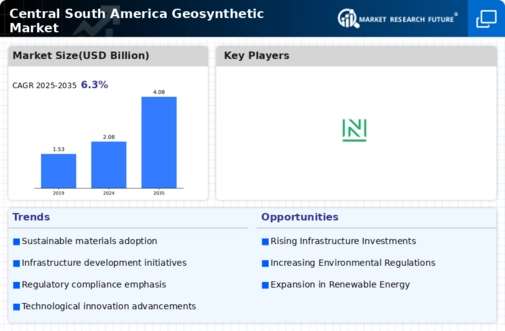Market Growth Projections
The Global Central South America Geosynthetic Market Industry is projected to experience substantial growth over the coming years. With a market value anticipated to reach 2.08 USD Billion in 2024, the industry is on track for a robust expansion trajectory. By 2035, the market could potentially double in size, reaching 4.08 USD Billion. This growth is underpinned by a compound annual growth rate (CAGR) of 6.32% from 2025 to 2035, indicating a strong demand for geosynthetic materials across various applications, including civil engineering, environmental protection, and infrastructure development.
Technological Advancements
Technological advancements are significantly influencing the Global Central South America Geosynthetic Market Industry. Innovations in material science and manufacturing processes have led to the development of high-performance geosynthetics that offer enhanced durability and functionality. For example, advancements in polymer technology have resulted in geogrids and geotextiles that provide superior strength and longevity. These innovations are likely to attract a broader range of applications, from road construction to environmental protection. As a result, the market is expected to grow, with projections indicating a value of 4.08 USD Billion by 2035.
Growing Construction Sector
The expansion of the construction sector is a primary driver of the Global Central South America Geosynthetic Market Industry. As urbanization accelerates, there is an increasing demand for infrastructure development, including roads, bridges, and buildings. Countries like Argentina and Chile are witnessing significant construction activities, which in turn fuels the demand for geosynthetic products. This growth in construction is expected to contribute to the market's value, with estimates suggesting a rise to 2.08 USD Billion in 2024 and a potential increase to 4.08 USD Billion by 2035.
Regulatory Support and Standards
Regulatory support and the establishment of standards play a crucial role in the Global Central South America Geosynthetic Market Industry. Governments are implementing policies that encourage the use of geosynthetics in construction and civil engineering projects. For instance, regulations mandating the use of geosynthetic liners in landfills and containment systems are becoming more prevalent. This regulatory framework not only enhances the safety and efficiency of projects but also fosters market growth. As the industry adapts to these regulations, the market is poised for expansion, with a projected value of 2.08 USD Billion in 2024.
Environmental Sustainability Focus
There is a growing emphasis on environmental sustainability within the Global Central South America Geosynthetic Market Industry. As nations strive to meet international environmental standards, geosynthetic materials are increasingly recognized for their role in reducing ecological footprints. For example, the use of geotextiles in erosion control and soil stabilization minimizes land degradation and promotes sustainable land use practices. This shift towards eco-friendly solutions is likely to drive market growth, as stakeholders prioritize sustainable construction methods and materials. The anticipated market value of 4.08 USD Billion by 2035 underscores the potential impact of this trend.
Infrastructure Development Initiatives
The Global Central South America Geosynthetic Market Industry benefits from ongoing infrastructure development initiatives across the region. Governments are increasingly investing in transportation networks, water management systems, and urban development projects. For instance, Brazil's infrastructure investment plan aims to enhance road and rail networks, which could lead to a heightened demand for geosynthetic materials. This trend is expected to contribute to the market's growth, with projections indicating a market value of 2.08 USD Billion in 2024 and a potential increase to 4.08 USD Billion by 2035, reflecting a compound annual growth rate (CAGR) of 6.32% from 2025 to 2035.












Leave a Comment